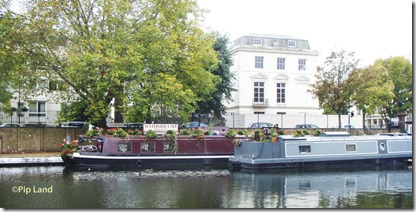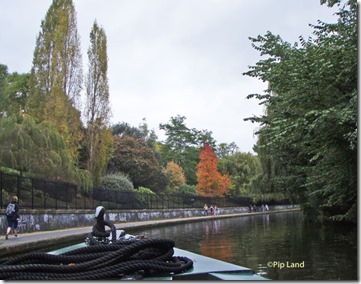At Warwick Avenue Station we left behind the hurly burly of modern London and stepped into the dream world of a Prince Regent who wanted to create an elegant London with beautiful open spaces. So Warwick Avenue is broad and lined with large Regency white stuccoed houses which are as fashionable today as they were when built in the mid 19th century. The houses we passed in Warwick Place were not as large but just as elegant. Our destination was Little Venice and we couldn’t think of a better way to spend a beautiful sunny autumn day in London than going on a boat ride along Regent’s Canal.
We crossed the Westbourne Terrace Turnover Bridge where the Paddington Arm of the Grand Union Canal flows into Browning’s Pool (otherwise known as “Little Venice Lagoon” or just “The Lagoon”) to reach the Waterside Cafe where we rendezvoused with my son Eddie.There was a bit of a wait to get served but it was worth it for David and Eddie enjoyed their meals there and I spoilt myself with a slice of orange polenta cake (minus cow’s milk products). Below: Waterside Cafe. Click on this picture to see a photographic trip along Regent’s Canal.
Surrounded by grand houses, modern flats and many visitors it was hard to picture the days when the area was in the open countryside. When the first houses were built in the 1840s they provided a haven for those who wanted to escape the thick, yellow London pea-soupers. Robert Browning lived there for a while in the 1860s before migrating to Venice. These days the Regency buildings he knew are overlooked by modern apartments but he has not been forgotten.
A gondola trip around the willow-draped island in the middle of the Lagoon was on offer while a group of novice paddleboarders made their way slowly past the Rembrandt Garden and the queue of tourists waiting for the London Waterbus. We were heading for Jason’s Canal Trip moorings and so we crossed the Turnover Bridge again to await the arrival of the 109-year-old narrowboat. Even though we weren’t the first in that queue we were allowed on board first because I had booked tickets in advance.
As we waited for the trip to begin we watched as a “working” canal boat delivered supplies to another narrowboat. We were reminded that British canals had come into existence in the 18th and 19th centuries and were essential to Britain’s industrial success because they provided an excellent way to transport millions of tonnes of heavy goods throughout the country before the advent of the railways.
Regent’s Canal was completed in 1820 to provide a link from the Paddington Arm to Limehouse. Architect John Nash was a director of the Regent’s Canal Company set up in 1812 and described it as “barges moving through an urban landscape”. The bulk of the river traffic then served the industrial heart of the city but Nash and his assistant James Morgan ensured that there was much to enjoy and in the mid 19th century there were pleasure boats on The Lagoon. The beauty of Regent’s Canal is that for many miles even today it provides an escape from London’s urban landscape.
Canals began to fall into disuse and decay from the mid 20th century because the narrowboats could no longer compete with both railway and lorry transport. Thanks to the efforts of many volunteers throughout the country hundreds of miles of canals have been restored. According to the Canal and River Trust charity, in 1969 Regent’s Canal was unused and unloved. That certainly can’t be said today. The Trust has contributed a lot towards creating better and more open spaces as our journey along Regent’s Canal showed.
As Jason’s Boat pulled away our guide began his cheerful and informative description of the canal’s history and the sights along the way. We left the Lagoon and passed under Bridge No 1 on the Regent’s Canal: the late 19th century grade II listed Warwick Avenue Bridge with its ornamental iron railings. Now we were gently travelling past Maida Avenue and Blomfield Road towards the 272 yards (249m) long Maida Hill Tunnel.
Brightly painted narrowboats lined the edges of the canal on some of the most prestigious moorings in London. Ahead was the Cafe Laville in Edgware Road marking the beginning of the tunnel. Our guide explained that when the 201-year-old tunnel was being built it cut through part of the outfield of what was the second site of the Lord’s Cricket Ground. Spoil from the diggings were used to level land to the north of the canal so that a new cricket ground could be created.
Our guide also told us about how men had originally had “legged” horse-drawn narrowboats through the canal by laying on top on their backs and using their legs to push the boats along while the horses were led to the other side of the tunnel. Jason’s boat had been a cargo vessel until it was fitted with a diesel engine and, in 1951, was the first he said to be used for tourist trips between Camden Lock and Little Venice.
Not long after leaving the tunnel we came to a wider section of the canal where the permanent narrowboat moorings are overlooked by modern apartment blocks and the very large St John’s Wood Electricity Sub-station. Once upon a time coal boats moored there to deliver supplies to a power station.
We were then embraced by trees in their autumn plumage as we entered Regent’s Park. Neo-classical mansions towered above us remindPaing us that Nash had originally planned to line the canal with grand houses. That dream was partly realised when Quinlan Terry was commissioned in the late 1980s to design those now on the south bank of the canal.
Our guide told us all about Macclesfield Bridge – or rather Blow-Up Bridge. It got that name after a narrowboat carrying gunpowder and petroleum blew up in October 1874. The three members of the crew were killed and the bridge was demolished. The Doric arches were put up again and the bridge was rebuilt.
Soon we were on our way through Regent’s Park Zoo, spotting some African wild dogs and the Snowden Aviary before coming upon the splendid Feng Shang Princess (a floating Chinese restaurant) and turning towards Primrose Hill. At this point we were heading back into industrial London leaving behind that haven of tranquility.
The towpath along the canal is now part of the 37 mile Jubilee Greenway walk which came into being to celebrate the Queen’s Diamond Jubilee. The canal and its unique industrial heritage are protected by being in a conservation area.
Before long we were passing The Pirate Castle which is the base for a boating and outdoor activities charity. As we headed for Camden Lock I thought it was so nice to see people sitting on the edge of the towpath , their legs dangling over the canal, eating their lunch. Behind them were the Lock House apartments in what had been one of the main warehouses on the 20 acre W & A Gilbey Ltd site in the late 19th and early 20th centuries.
We could see the Interchange Warehouse (now the home of Associated Press TV News) and the 19th century Roving Bridge which was once used to move horses from one towpath to another.Then we understood how well those by Lock House had escaped the crowds. As we disembarked near the Roving Bridge we were enveloped by a mass of people as we tried to make our way past the international choice of food on offer at various kiosks and the stalls offering a wide selection of clothes, music, art and so much more.
It is said that the market is one of London’s most populated tourist destinations and it is estimated that over 11,000 visit it at weekends. David commented that all 11,000 seemed to be there that afternoon. All David and I wanted to do was to get out. What a chaotic and noisy contrast to the tranquility and harmony of nature we had experienced on the way through Regent’s Park. Even outside of the market it was difficult to find somewhere to sit and have a cup of coffee.
David decided it was time to leave as quickly as possible and Eddie flagged down a taxi for us. We felt as if we were on a magical tour of London, sitting in comfort in a real taxi watching all the people and the traffic in comfort. It was fascinating to see not just what remains of the Prince Regent’s dream but also the new buildings, especially the skyscrapers.
With hundreds more skyscrapers soon to be built it seems London will become one large building site. But sadly there seems to be very little coherent design as architects and developers compete to dominate London’s skyline. The London I knew as a child is fast disappearing – which made our journey along the Regent’s Canal even more special. Below: Passing through Regent’s Park.

